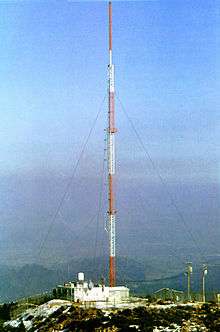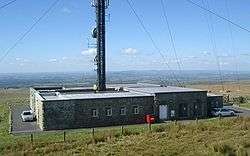Guyed mast
A guyed mast is a tall thin vertical structure that depends on guy lines for stability. The mast itself has the compressive strength to support its own weight, but does not have the shear strength to stand unsupported, and requires guy lines to resist lateral forces such as wind loads and keep it upright. Guy lines are diagonal tensioned cables attached to the ground, usually spaced at equal angles about the structure's base.


Guyed masts are frequently used for radio antennas. The mast can either support aerials (for VHF and UHF) mounted at its top, or the entire structure itself can function as an antenna (for VLF, LF, MF); this is called a mast radiator. In the latter case, the mast needs to be insulated from the ground. Guyed radio masts are typically tall enough that they require several sets of guy lines, 2 to 4, attached at different heights on the mast, to prevent them from buckling. An exception was the Blaw-Knox tower, widely used during the 1930s, whose distinctive wide diamond (rhomboidal) shape gave it the shear strength that it only required one set of guys.
Sailing masts, the masts that support the sails on sailboats, are also typically guyed masts.
Guyed masts are sometimes also used for meteorological measurements at certain heights above ground level. Sometimes they are used as pylons, although their usage in agricultural areas is problematic because anchor foundations handicap ploughing.
A partially guyed tower is a structure consisting of a guyed mast on top of a freestanding tower. The guys may be anchored to the top of the freestanding structure, or to the ground. A famous tower of this type is the Gerbrandy Tower.
An additionally guyed tower is a freestanding tower which either has guys attached temporarily to add stability, for example during construction, or guys attached in only one direction to support unidirectional shear stresses. An example of the latter type is a utility pole at the end of a power line where the line ends or angles off in another direction. The pole requires guys in only one direction to support the unbalanced lateral load of the power line in the other direction.
The tallest guyed mast in the world is currently the 2,063 feet (629 m) KVLY-TV mast near Blanchard, North Dakota, USA.
See also
- List of masts for examples of guyed mast structures.
- Radio masts and towers
Gallery
| Wikimedia Commons has media related to Guyed masts. |
- Guyed mast guy line
- Guyed mast guy line anchor
 Guyed mast transmitter building
Guyed mast transmitter building